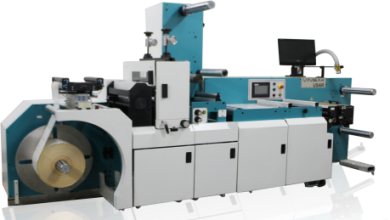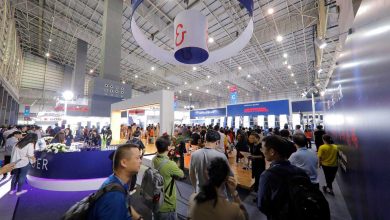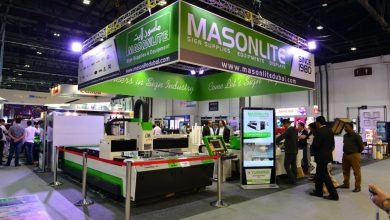“Drupa is not so much a trade show as it is a roadmap”
What were the important themes of drupa 2016?
1. B2 (4-up) and B1 (8-up) digital-based sheetfed presses. Quality is no longer an issue in digital versus offset as digital presses approach offset press speeds.
2. New inks that do not require coated or treated paper, or pre-coating. The ink revolution has begun.
3. 5- to 7-color digital presses that claim to print 95 percent of the Pantone colors.
4. Digital package printing with folding carton and corrugated digital presses galore. Digital printing of flexible film was demonstrated as were over 20 models of digital label presses.
5. Roll-fed digital presses from narrow to very wide were churning out “longer short runs” of color printing.
6. Systems for embellishing paper and other materials with laser diecutting, metallic printing, embossing, and coating.
7. Process automation with cloud-based workflows and systems for machine monitoring and service.
8. Printed electronics plus 3-D printing in many shapes and sizes.
B2+ digital – Many commercial printers need the B2+-format press platform that has served them well for offset printing. The reason is simple: every customer job has a different paper stock and sheetfed presses are better at this than roll-fed presses. The new generation of B2+-format digital printing devices fit easily into existing production lines with minimal disruption. The smaller cut-sheet digital devices are reaching the saturation point in jobs that can be effectively moved from the larger sheetfed offset presses.
 drupa 2016 saw the arrival of larger format digital cut-sheet color printing systems as well as off-line systems for special effects such as spot gloss, dimensional effects, and metallic foils. The progress in B2+ sheet-fed design is facilitated by wider inkjet arrays based on advances in inkjet head technology. The challenge for these larger format digital printing devices is to produce the quality, consistency, substrate support, and color registration while operating at high speed. Also important is integration of finishing technologies that leverage the benefits of digital print.
drupa 2016 saw the arrival of larger format digital cut-sheet color printing systems as well as off-line systems for special effects such as spot gloss, dimensional effects, and metallic foils. The progress in B2+ sheet-fed design is facilitated by wider inkjet arrays based on advances in inkjet head technology. The challenge for these larger format digital printing devices is to produce the quality, consistency, substrate support, and color registration while operating at high speed. Also important is integration of finishing technologies that leverage the benefits of digital print.
The Landa S10 Nanographic Press runs at 13,000 B1 sheets per hour. Landa reported $450 Million in sales from the show. The Konica AccurioJet KM-1 switched from water-based ink to UV ink, which allows printing on any substrate. The ink is unique in that it is a matte version that eliminates the gloss of traditional UV inks. Komori was a partner and also sells a version of the press. Heidelberg Primefire 106, co-developed with Fujifilm for personalized packaging and other commercial and industrial applications (29.53″ x 41.73″) can print up to 2,500 sheets per hour in seven colors. Fujifilm announced that over 80 of its B2 version are in use worldwide. The prototype Canon Voyager is a B1 press that inkjets water-based ink to a blanket and then onto the substrate. RMGT (Ryobi Mitsubishi Graphic Technology) demonstrated a digital sheetfed press. The 4-color B2 press is based on a Ryobi 750 offset press structure uses Miyakoshi’s high viscosity liquid toner technology
InfoTrends calls what is happening Inkjet 3.0. After many advances in production inkjet printing at drupa 2008 and 2012, this drupa had many new and improved print heads, higher print quality levels, wide printhead arrays, improved performance on a range of substrates, and expansion across a range of document, packaging, and decorative applications. Especially important were new ink formulations that can print on many substrates without special coatings, treatment, or pre-coating. These developments have brought digital printing into the forefront of the industry. The offset press vendors had little that was new and are now committed to a digital print strategy.
Many of the digital press suppliers reported that their 5- to 7-color presses can achieve 95 percent of the Pantone colors. HP Indigo has long had the advantage of handling brand color but now Xerox, Kodak NexPress, Canon, Ricoh, Konica, and others have similar capabilities.
 Digital printing of packaging, digital embellishment, and digital die-cutting were integrated across many production lines for labels, folding cartons, corrugated packaging, flexible packaging, and direct-to-shape applications. drupa now has a significant package printing component. Meeting the needs of different segments of the packaging market is a challenge that requires effective software, workflow, and finishing if the advantages of digital print for the entire supply chain are to be gained. Digital printing system vendors must understand the magnitude of this.
Digital printing of packaging, digital embellishment, and digital die-cutting were integrated across many production lines for labels, folding cartons, corrugated packaging, flexible packaging, and direct-to-shape applications. drupa now has a significant package printing component. Meeting the needs of different segments of the packaging market is a challenge that requires effective software, workflow, and finishing if the advantages of digital print for the entire supply chain are to be gained. Digital printing system vendors must understand the magnitude of this.
Landa, Kodak, Xerox and others showed printing on flexible films. The Gallus Labelfire 340, an 8-color UV inkjet label press was available with inline diecutting and other finishing options.
The EFI Nozomi is a sheetfed, LED-curing inkjet press built to print corrugated boards in a single pass at speeds up to 75 linear meters (246 linear feet) per minute. HP announced something similar with no specs and possible delivery in 2018. HP Indigo is doing extremely well with its fleet of B2 liquid toner printer/presses for many applications.
Laser cutting and creasing, particularly for folding carton applications, is also advancing, and for some of these devices the focus is on a B1 sheet size. For the off-line digital devices used for special effects, the B1 sheet size opens up opportunities because these systems are capable of supporting conventional presses as well as digital printers. Digital paper cutting and creasing are the functions performed by equipment from Highcon, which made its drupa debut in 2012. The product line now consists of three machines—Beam, Euclid III, and Pulse—that create special effects for labels, packages, commercial and display products, greeting cards, clothing, corrugated cartons, and point-of-sale applications. A system in prototype, the Highcon Shape, cuts paperboard into molds for spectacular 3D objects.
Highcon systems crease and cut without conventional die tooling. Sheets can be laser-cut with intricate patterns for on-demand, small-run production of boxes and other items. This makes it possible to create high-value versioned and personalized packages that would be cost-prohibitive to produce using analog finishing methods.
 Roll-fed dominates the digital printing arena. Canon/Océ, HP, Kodak, Ricoh, Screen, Xeikon, Xerox, and others, including suppliers, who have mounted inkjet heads from HP and Kodak on roll-fed mechanisms, all had new and improved systems. These devices are finding wide application and dominate where “longer short runs” are required. The high-speed Xeikon Trillium uses liquid toner for packaging applications.
Roll-fed dominates the digital printing arena. Canon/Océ, HP, Kodak, Ricoh, Screen, Xeikon, Xerox, and others, including suppliers, who have mounted inkjet heads from HP and Kodak on roll-fed mechanisms, all had new and improved systems. These devices are finding wide application and dominate where “longer short runs” are required. The high-speed Xeikon Trillium uses liquid toner for packaging applications.
Embellishment and special effects – Offset print processes have typically printed special effects beyond process color such as spot gloss, flood coats, foils, and corporate color matching. This kind of embellishment is now accelerating for digital print. Electrophotographic devices are using effects like printed metallic, dimensional, clear gloss, spot colors, fluorescent, security and other embellishments to differentiate the printed products and provide added value. Inkjet, particularly with ultraviolet (UV) curing inks, is extending this with some eye-popping results that leverage dimensional clear and metallic foil. The use of hybrid configurations, including those that leverage electrophotography and inkjet together, will have compelling applications in commercial and packaging markets.
Many off-line special effect solutions are now able to support larger format conventional sheet sizes. The Scodix E106 enhancement press for the commercial printing and folding carton market is a digital press delivering enhancement solutions. Offered in a B1 (1060x760mm) format at up to 4,000 sph, it can provide effects for embossing, glittering, foiling, coating, and more in a single pass. MGI also has a line of enhancement devices. Lana showed a metallizing system that has zero waste.
Industry 4.0 and the industrialization of print – System suppliers have talked about how production data can be used to drive operational efficiency and predict service calls. Cloud-enabled production data tracking is now making data-driven production a reality. Most systems are based on a single vendor platform with performance benchmarking across peers with similar equipment. Automated workflows make it easy for production management to assess and react based on real-time data. Semi-autonomous print production and robotic automation will establish a foundation for a new industrial revolution that is based upon automation and data exchange in manufacturing technologies. This will lower labor involvement and bring work back that has been lost to other parts of the world.
Printed electronics and 3D printing will likely have a sizeable impact moving forward. drupa had two halls devoted to new technology. Their Cube presentations and touchpoints helped to educate attendees about these new technologies. They have great potential but we need to figure how to make money with them.
There were lesser, but important, themes. Integrated finishing, improved color management, more automated workflows, and new no-process plates stood out.
Even though slightly smaller than previous years, the show was overwhelming. HP had their own building, and Heidelberg shared theirs with third-party partners. The announcement that the next drupa would take place in 2020 instead of 2019 was a relief. Few vendors were looking forward to making the marketing investments required for drupa on a 3-year cycle. Final attendance reached 260,000, down from 318,000 at drupa 2012, much of that drop attributed to the shortening of the show from 14 to 11 days. Sales reports from exhibitors have been very positive.




